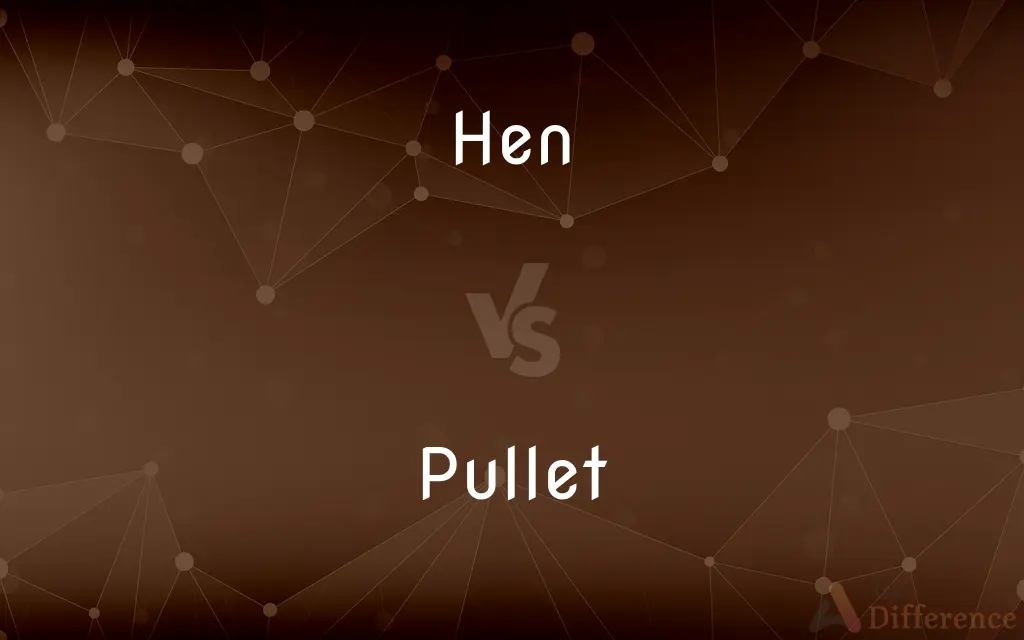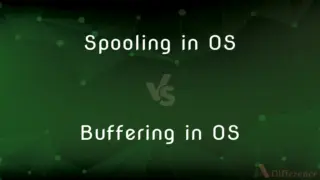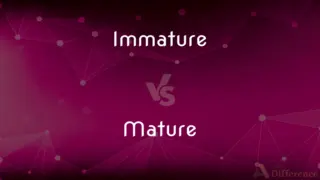Hen vs. Pullet — What's the Difference?
By Tayyaba Rehman & Urooj Arif — Published on February 9, 2024
A hen is a mature female chicken, typically over a year old, known for egg-laying. A pullet is a young female chicken under one year, not yet in full egg-laying maturity.

Difference Between Hen and Pullet
Table of Contents
ADVERTISEMENT
Key Differences
In poultry terminology, a hen is an adult female chicken. This term is widely recognized and used when referring to female chickens that have reached maturity, generally over one year of age. Hens are primarily known for their ability to lay eggs, a trait that has made them integral to both commercial egg production and backyard farming. On the other hand, a pullet refers to a young female chicken that has not yet reached this stage of maturity. Pullets are in the transitional phase from chick to hen, a period that is crucial for their growth and future egg-laying capabilities.
The life of a hen begins as a pullet, a term denoting their juvenile stage. During this time, pullets develop physically, their reproductive systems mature, and they gradually start to exhibit the physical characteristics of a hen. While hens are fully grown and often have a fuller, more rounded appearance indicative of their maturity, pullets are typically slimmer and smaller, as they have not yet reached their full adult size or weight. The distinction between a hen and a pullet is not just physical but also relates to their role in the poultry world, with hens being the primary egg producers.
Egg production is a significant difference between hens and pullets. While a hen is actively laying eggs and may even be part of a breeding program, a pullet is still too young for consistent egg production. Pullets might start laying eggs at about 5 to 6 months of age, but these early eggs are often smaller and less frequent. In contrast, hens are at the peak of their egg-laying ability, with egg size, frequency, and quality being more consistent.
In terms of behavior, hens and pullets can exhibit different patterns. Hens are generally more settled and less active compared to pullets, which can be more energetic and skittish. This behavioral difference is partly due to the maturity and experience of hens compared to the youthful exuberance of pullets. Additionally, in a flock, hens usually establish a pecking order, a hierarchical system that determines their social standing, whereas pullets are still navigating and finding their place within this structure.
While both hens and pullets play vital roles in the lifecycle of chickens, their contributions differ significantly due to their stages in life. Hens are the cornerstone of egg production and often represent the mature, stable component of the flock. In contrast, pullets symbolize potential and growth, the future egg layers, and possibly mothers, that will sustain and continue the flock.
ADVERTISEMENT
Comparison Chart
Age
Adult, typically over a year
Young, under a year
Egg-laying Status
Consistent egg layer
Begins laying at 5-6 months
Physical Appearance
Fuller, more rounded
Slimmer, smaller
Role in Flock
Established, often dominant
Finding place, lower hierarchy
Usage in Sentences
Often singular or plural
Primarily singular
Compare with Definitions
Hen
A term used colloquially to refer to a woman, often in a social context.
The hens gathered at the café for their weekly catch-up.
Pullet
Used in farming to denote a female chicken raised primarily for meat or egg production.
The farmer counted the pullets to ensure none had wandered off.
Hen
An adult female chicken.
The hen clucked contentedly as she pecked at the grain.
Pullet
A term representing youth and immaturity in the context of poultry.
The pullet was not yet ready to lay eggs, still growing and maturing.
Hen
A metaphor for protective or nurturing behavior, often associated with motherhood.
She was a hen with her children, always watching over them with care.
Pullet
A young female chicken, especially one less than one year old.
The pullet fluffed her feathers as she explored the coop.
Hen
The female of certain aquatic animals, such as an octopus or lobster.
Pullet
In culinary terms, a young chicken suitable for certain types of dishes.
The recipe called for a pullet, known for its tender and flavorful meat.
Hen
Often Offensive Slang A usually older woman, especially one who is engaged in conversation with other women.
Pullet
A young domestic hen, usually one that is less than one year old.
Hen
(uncommon) A female fish (especially a salmon or trout) or crustacean.
Pullet
A young hen, especially one less than a year old.
Hen
A woman, particularly
Pullet
(slang) A spineless person; a coward.
Hen
A bride-to-be, particularly in the context of her "hen night" festivities.
Pullet
A young girl.
Hen
A hen night.
Pullet
A young hen, or female of the domestic fowl.
Hen
An affectionate term of address used to women or girls.
Don't cry, hen. Everything will be all right.
Pullet
Flesh of a medium-sized young chicken suitable for frying
Hen
The hard clam (Mercenaria mercenaria), a bivalve shellfish.
Pullet
Young hen usually less than a year old
Hen
(dialectal) Hence.
Pullet
A bird in its early stages of development, before reaching full maturity.
The pullets huddled together, still reliant on warmth and protection.
Hen
(dialectal) To throw.
Hen
The female of the domestic fowl; also, the female of grouse, pheasants, or any kind of birds; as, the heath hen; the gray hen.
Hen
Flesh of an older chicken suitable for stewing
Hen
Female of certain aquatic animals e.g. octopus or lobster
Hen
In bird species, the female, especially when distinguished from the male, known as the cock.
The hen guarded her nest fiercely from any intruders.
Hen
Used in various phrases and idioms to symbolize domesticity or fussiness.
She fussed over the details like a mother hen with her chicks.
Common Curiosities
What is a hen?
A hen is an adult female chicken, typically over a year old, known for laying eggs.
What is a pullet?
A pullet is a young female chicken under one year of age, not yet in full egg-laying maturity.
At what age does a pullet become a hen?
A pullet typically becomes a hen at about one year of age, when she starts laying eggs regularly.
Can both hens and pullets lay eggs?
Yes, both can lay eggs, but pullets start laying at about 5-6 months, and their eggs are smaller and less frequent.
What is the role of pullets in a flock?
Pullets represent growth and potential, as future egg layers and possibly mothers.
What should I feed my pullets and hens?
Pullets need a diet rich in protein for growth, while hens require a balanced diet with calcium for egg production.
How to distinguish a hen from a pullet physically?
Hens are fuller and more rounded, while pullets are slimmer and smaller, reflecting their younger age.
Do hens and pullets behave differently?
Yes, hens are generally more settled, while pullets are more energetic and skittish.
How do hens contribute to a flock?
Hens are primary egg layers and often hold higher positions in the flock's social hierarchy.
How long do hens lay eggs?
Hens lay eggs for several years, but their peak production is typically between 1 and 3 years of age.
Why is it important to know the difference between a hen and a pullet?
Understanding the difference helps in managing their care, nutrition, and expectations regarding egg production.
Is it better to have hens or pullets for egg production?
For consistent egg production, hens are preferable, but pullets are essential for flock sustainability and growth.
Can pullets and hens live together?
Yes, they can coexist, though establishing a pecking order and ensuring proper space and resources is crucial.
Do pullets need special care compared to hens?
Yes, pullets need protective care, proper nutrition for growth, and gradual integration into the flock.
How can I tell if my chicken is a hen or a pullet?
Age, physical appearance, and egg-laying patterns are key indicators of whether a chicken is a hen or a pullet.
Share Your Discovery

Previous Comparison
Spooling in OS vs. Buffering in OS
Next Comparison
Immature vs. MatureAuthor Spotlight
Written by
Tayyaba RehmanTayyaba Rehman is a distinguished writer, currently serving as a primary contributor to askdifference.com. As a researcher in semantics and etymology, Tayyaba's passion for the complexity of languages and their distinctions has found a perfect home on the platform. Tayyaba delves into the intricacies of language, distinguishing between commonly confused words and phrases, thereby providing clarity for readers worldwide.
Co-written by
Urooj ArifUrooj is a skilled content writer at Ask Difference, known for her exceptional ability to simplify complex topics into engaging and informative content. With a passion for research and a flair for clear, concise writing, she consistently delivers articles that resonate with our diverse audience.
















































